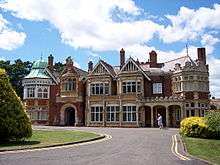Margot Sandeman
| Margot Sandeman | |
|---|---|
| Born |
Margot Sandeman 27 May 1922 Glasgow, Scotland |
| Died | 17 January 2009 (aged 86) |
| Education | Glasgow School of Art |
| Known for | Painting |
| Notable work | Sheep Resting on the Shore |
| Spouse(s) | James Robson |
.jpg)
Margot Sandeman (27 May 1922 — 17 January 2009) was a Scottish painter, close friend of Joan Eardley and long-time collaborator with poet Ian Hamilton Finlay.
Early life
Margot Sandeman was born in Glasgow to a family of Scottish artists, the daughter of self-taught watercolourist Archibald Sandeman (1887-1941), and internationally known embroiderer Muriel Boyd (1887-1981).[1][2] Sandeman grew up in Bearsden in a creative household, influenced by William Morris and the Arts and Crafts movement.[1] The family home was decorated by her mother with texts such as "Bread feeds the body but flowers the soul".[1]
Studies
Sandeman studied at the Glasgow School of Art, where her contemporaries included Joan Eardley and the poet Ian Hamilton Finlay.[1][2] Sandeman was already a confident painter when she began art school and, like Eardley, one of a small group selected for special training by the head of drawing and painting, Hugh Adam Crawford. Both artists flourished under his experimental fast-track treatment.[2] Crawford commented on “the inner structure [of Sandeman's paintings], which is not an optical thing.”[1]
Relationship with Joan Eardley

Sandeman and Eardley met for the first time at Glasgow School of Art and became close friends.[3][4]
"We were very shy of each other for about a year," Sandeman remembers. "But Joan's mother and my mother enticed us to do a Red Cross course together. We started having to bandage each other, that broke the ice! After that we became tremendously great friends." [3]
Both lived in Bearsden and, although their styles were very different, they encouraged and supported each other,[5] drew and painted together, and shared camping trips and family holidays.[2] In 1941, as students, Sandeman and Eardley acquired a horse and caravan and travelled, sketched and painted around Loch Lomond.[2] For many years, the two women regularly visited High Corrie on the Isle of Arran, renting an outhouse, “The Tabarnacle”, as a studio.[1][3]
In a review of a 1940s Society of Scottish Artists exhibition, a Scotsman art critic said,
"Miss Joan Eardley and Miss Margot Sandeman more than maintain the exciting promise of their first appearances […] Both are quite fearless and convinced exponents of highly individual outlooks."[3]
Work

Sandeman graduated from Glasgow School of Art during World War II and in 1942 was sent to Bletchley Park, where she worked for six months as a code-breaker.[2][1]
After leaving Bletchley to care for her mother, Sandeman took a studio in Glasgow. Her first work there was a series of vivid still-lives while, for paid employment, she painted antique effects on lampshades.[1]
In 1946 she married the teacher, potter and ceramic artist James Robson, with whom she had two sons.[2]
Prolific and wide-ranging, Sandeman worked in the open air, in the studio, and from memory, creating unique interpretations of West Coast Scottish landscapes, rural settings, interiors and still lives.[2] She collaborated regularly with poet Ian Hamilton Finlay.[2][4]
In later life Sandeman's range and output continued to increase, including a notable suite of paintings in celebration of Scottish dramatist and poet Robert McLellan, a neighbour in High Corrie.[1][2]
Exhibitions and awards
Sandeman exhibited at The Royal Scottish Academy from 1946-1972[6]
Sandeman's principal solo exhibitions were at the Richard Demarco Gallery, Edinburgh from 1974 onwards.[7] She also exhibited at the Hughson Gallery, Glasgow, the Talbot Rice Gallery, Edinburgh, and the Lillie Art Gallery, Glasgow.[1] In 1964 Sandeman won the Guthrie Award of the Royal Scottish Academy and in 1970, the Redpath Award from the Society of Scottish Artists.[8] She also received a Scottish Arts Council award in 1970.[7] In 1989 she was Scottish winner in the Laing Competition.[2]
See also
References
- 1 2 3 4 5 6 7 8 9 10 "Margot Sandeman: Scottish painter | The Times". The Times. Retrieved 2016-03-12.
- 1 2 3 4 5 6 7 8 9 10 11 "Margot Sandeman". Herald Scotland. Retrieved 2016-03-12.
- 1 2 3 4 "Brush with greatness". www.scotsman.com. Retrieved 2016-03-12.
- 1 2 "Sandeman Margot – University of Stirling". www.stir.ac.uk. Retrieved 2016-03-12.
- ↑ Andreae, Christopher (2013). Joan Eardley. Lund Humphries. pp. 47–48. ISBN 9781848221147.
- ↑ "Margot Sandeman - Mapping the Practice and Profession of Sculpture in Britain and Ireland 1851-1951". sculpture.gla.ac.uk. Retrieved 2016-03-12.
- 1 2 David Buckman (1998). Artists in Britain Since 1945 Vol 2, M to Z. Art Dictionaries Ltd. ISBN 0 95326 095 X.
- ↑ Frances Spalding (1990). 20th Century Painters and Sculptors. Antique Collectors' Club. ISBN 1 85149 106 6.
External links
- Paintings by Margot Sandeman on ArtUK
- Modern Scottish Women - uncovering a vital period in art history
- "Barges" by Ian Hamilton Finlay, illustrated by Margot Sandeman